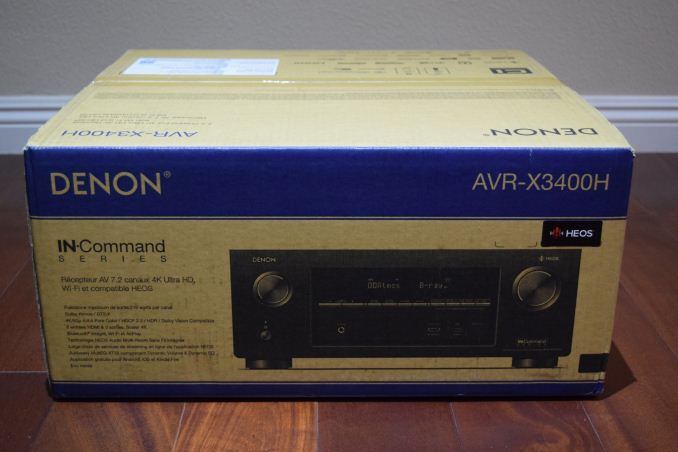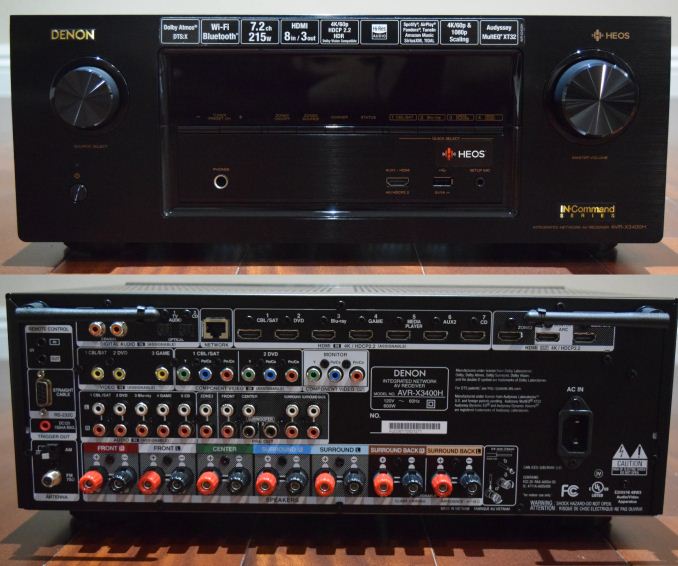A Budget Home Theater & PC Setup: 4K, HDR, UHD Blu-ray, and More
by Ganesh T S on December 26, 2017 8:30 AM ESTThe AVR: Denon X3400H
The choice of AVRs used to be a difficult one to make when support for different HD audio formats was not widespread. Now, the requirements boil down to the AVR being able to support the latest HD audio formats (Dolby Atmos and DTS-X), while matching the capabilities of the display in the chain. The additional features may help sway the purchase decision for consumers.
Budget considerations dictate the number of channels and display zones. We had to migrate from the 7.1 channel Pioneer Elite VSX-32 to a newer receiver capable of handling multiple HDMI 2.0 / HDCP 2.2 inputs with passthrough capabilities for various HDR formats. Based on my budget, I narrowed down the options to one of the models from Denon, Onkyo, Pioneer, and Yamaha. They are all in the same ball park in terms of pricing for a given feature set. We deferred to our friends at Wirecutter, who recommended the Denon AVR S730H.
I had been in touch with Denon regarding HEOS (their whole home audio solution) when the decision to go with a Denon AVR for our HTPC testing setup was taken. Upon discussing our project with them, Denon graciously agreed to sponsor the more advanced AVR X3400H for use in our testing.
The AVR X3400H targets the custom integrator channel. It has a number of additional features such as support for high end DSD audio, 4Kp60 upconversion for analog sources, multi-zone video outputs, higher power output, and support for eARC (Enhanced Audio Return Channel) to justify its higher price over the S730H. The presence of eARC makes it a bit more future-proof, as it allows for HD audio (including the new ones like Dolby Atmos and DTS-X) from the display sink to be returned to the AVR for decode and playback.
In the course of our testing, we found that the AVR received frequent firmware updates to add new features such as HLG passthrough. These point to a well-supported product. Even though the web control feature present in the previous generation Denon AVRs was missed, the Denon AVR Android app made up for it to some extent. None of the issues encountered in the course of the evaluation presented in this piece could be attributed to the Denon AVR X3400H.
If we had to give some suggestions to Denon for the improvement of the AVR X3400H, it would be to bring back the web control feature and shorten the time taken for firmware updates (though there is a facility to enable auto-updates that tries to install the new firmware when the AVR is not being used).
Speakers
Most readers upgrading their HTPC can opt to retain their existing speakers. In fact, I had the Boston Acoustics Horizon Series MCS100MDNT 5.1-channel speaker system from a 2008 purchase, along with a Jamo A306 HCS 5.1 speaker system from my 2011 home theater components upgrade. However, due to the remodel, I had to go in for in-ceiling speakers. I opted for a couple of the Polk Audio RC80i in-ceiling pairs for the rear and surround channel speakers. I bundled them along with ceiling speaker protective covers. The choice of speakers depends on the home theater size and other requirements. Currently, I am using the Jamo A306 speakers for the front, center, and subwoofer, with the Polk Audio RC80i for the other channels.












191 Comments
View All Comments
Alreyouano - Monday, January 1, 2018 - link
Sir, good day, im new in the home theater field. May i know what kind of speakers and how many do i need to buy to set up a 7.1.2 home theater at home. Thank you.Reflex - Monday, January 1, 2018 - link
Well to start the number you listed there actually tells you the total. 7.1.2 = 7 surround speakers (two front left/right, one center, one on each side, two behind), 1 subwoofer and 2 upwards firing drivers or ceiling mounted speakers for the space above the viewer.As to brands and so on you need to make certain your receiver or soundbar supports Dolby Atmos, I suggest avsforums.com for more info and user preferences.
Golgatha777 - Monday, January 1, 2018 - link
That would be 10 speakers if you include the subwoofer.5 up front (R,L,C, RP, LP), 4 in the back (RS, LS, RSB, LSB), and the subwoofer.
Reflex - Tuesday, January 2, 2018 - link
I think that's what I said? You included the RS/LS as 'back' and I listed them separately as "one on each side" in my description. One question I would have for you though: The upwards firing ones, if you only have 2 of them should they be front or back?I'm using a Samsung HW-K950 so it has four upwards firing drivers, but in a 7.1.2 you'd only have 2 presumably unless you drop the sides...
Alreyouano - Tuesday, January 2, 2018 - link
Thank you.kallek - Friday, January 5, 2018 - link
My biggest problem with HTCP's is the stutter from playing 23.976 clips. Using Reclock helps but it only works with some programs and I haven't got it to work well with DTS HD Master Audio and Dolby True HDVorl - Monday, January 15, 2018 - link
So, I haven't read all 18 pages of comments, so if this has been mentioned already, sorry.Why a 4k tv? They are a gimmick. If you sit more than a couple feet from your 55' TV, you can't see the difference. Here is a good link to explain it. https://referencehometheater.com/2013/commentary/4...
Sure, you can see the difference if you were gaming, and sitting NEXT to your monitor, but most people sit several to many feet from their TV, so even a big tv at 4k isn't something you can see. A lot of extra cost for no real gain.
mikato - Thursday, January 18, 2018 - link
Fun time reading the comments :) I’d just like to say that I came here and read it for the HTPC info. I would like to make a (better) HTPC but I won’t be upgrading my old home theater setup, so I wasn’t looking for stuff about receivers, TVs, etc. Doesn’t matter to me, but just figured I’d throw in my perspective. If I bought a new house or something, then I might be interested in that stuff. But as it is, I’ll be using what I have now for those items which work pretty darn well.iescheck2 - Wednesday, January 24, 2018 - link
It is not clear to me if the ASRock Beebox-S 7200U or Intel NUC7i7BNHX can stream Dolby True HD and DTS-HD MA through the HDMI to the AV receiver. Comparing those setups to a i5 notebook, what would be the advantages and disadvantages of each, since they may be similar in price?prateekprakash - Saturday, July 21, 2018 - link
Greetings @ganeshts .It would be great if you did a follow-up article, now that HDR & wcg mode works much better on windows 10.
I have a query: does the HDMI out of the pc go into the AVR, and the 4k60p out of the AVR goes to the TV?
I am asking this because I have my Sony x800d TV connected to my GTX 1060 HDMI out, and the windows sound icon shows only stereo and 5.1 as available options (the 7.1 option is greyed out).
Does that mean GTX 1060 HDMI out is limited to 6 channels only? Or is it somehow related to my msi b250 Mobo?
If I routed
GPU HDMI out>>AVR source in>>AVR>>AVR HDMI out>>TV
Would it then show 7.1 option?
I am new to home theatre space, and I intend to set-up my first home theatre, so I thought it would be wise to learn about it.